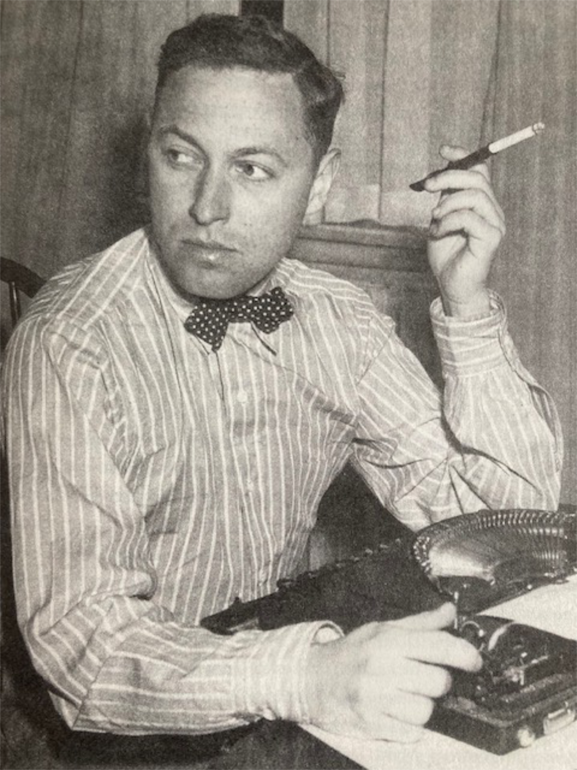
Tennessee Williams
*
January 14, 2024
by Philip Gambone
The great American playwright Tennessee Williams was a man of many passions. First and foremost was his passion for writing, especially for the theater, where he told the excruciating truth about people and their desires. But there were other passions which also governed, and sometimes overwhelmed, Williams: his search for love and "the kindness of strangers"; his passion for sex; for spiritual peace; and, alas, for alcohol and drugs, the compulsion that finally killed him. All of these passions, cravings, and manias he took with him on four trips to Mexico, trips he made, sometimes impetuously, to soak up material, to write, and to escape his demons.
Williams' first foray into Mexico occurred in 1939, when, after trying to break into the big-time drama world, he felt "slapped down." Living in New Orleans that year, writing "badly or not at all," he decided he needed a change. A musician he met, Jim Parrott, was on his way to Los Angeles and offered to drive Williams in his Ford V-8 to the West Coast: "no expense except meals on the road." It was an offer too good to refuse.
The 28-year-old struggling playwright and his friend traveled via the "Old Spanish Trail," through southern Texas and along the Mexican border. Twice they crossed into Mexico, through Ciudad Acuña and Juárez. Williams didn't record his impressions of this first dip south of the border, but the trip as a whole proved to be "a wonderful experience," he wrote to his mother. "I'm collecting lots of significant material on the way."
Before he left for California, Williams had entered some of his plays in a playwriting contest with the Group Theatre, a prestigious theater collective in New York. "I haven't heard a word from New York concerning my plays," he wrote to her again in early March. "I won't stay here long unless I can find work as I think L.A. is a thoroughly unattractive place to live unless you own your own car and can drive about the beaches and the hills."
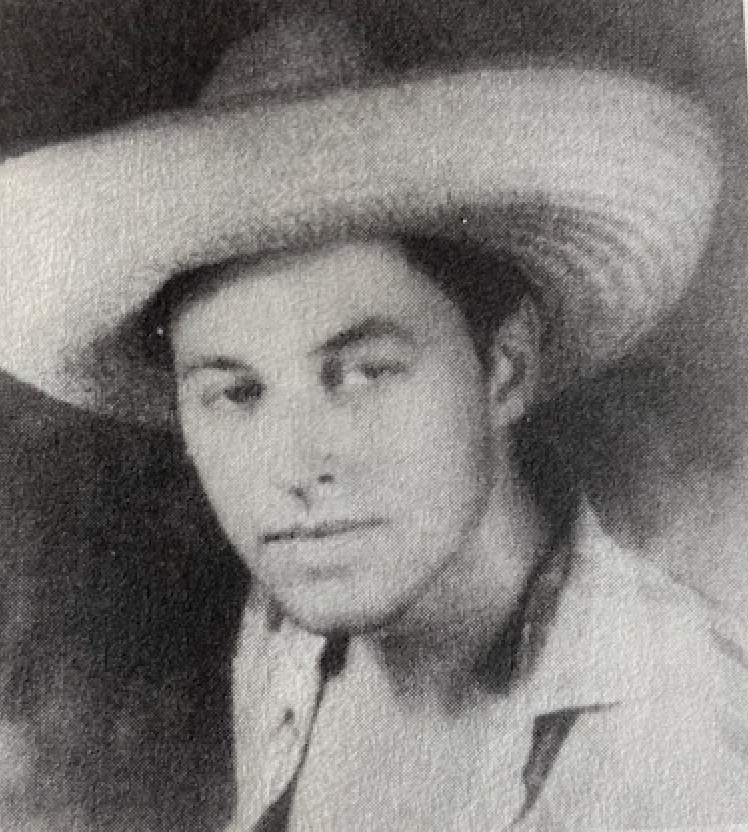
Williams in a sombrero
*
The unattractiveness was exacerbated by his stay at a pigeon ranch run by Jim's uncle. "The pigeons attract a great many flies," he reported to his father. To earn money, he took a job as a shoe store clerk for $12.50 a week.
On March 20, Williams' luck changed. He received a telegram from New York informing him that the Group Theatre, while not granting him first prize, had bestowed upon him a special award of one hundred dollars for "American Blues," a group of three sketches which constituted a full-length play. Agents in New York began to contact him.
In a manic elation, he wrote in his journal, "My next play will be simple, direct, and terrible—a picture of my own heart. There will be no artifice in it. I will speak the truth as I see it—distort as I see distortion—be wild as I am wild—tender as I am tender—mad as I am mad—passionate as I am passionate. It will be myself without concealment or evasion and with a fearless unashamed frontal assault upon life that will leave no room for trepidation … a passionate denial of sham and a cry for beauty." As Lyle Leverich points out in Tom: The Unknown Tennessee Williams, Williams had, in effect, written a manifesto for the rest of his literary career.
What most aspiring writers who had just come into this kind of good fortune would have done, as Williams himself later noted, would have been to head straight for Manhattan. Instead, for less than ten dollars, he bought a secondhand bike and, to celebrate, pedaled back down to Mexico, again with his friend Jim.
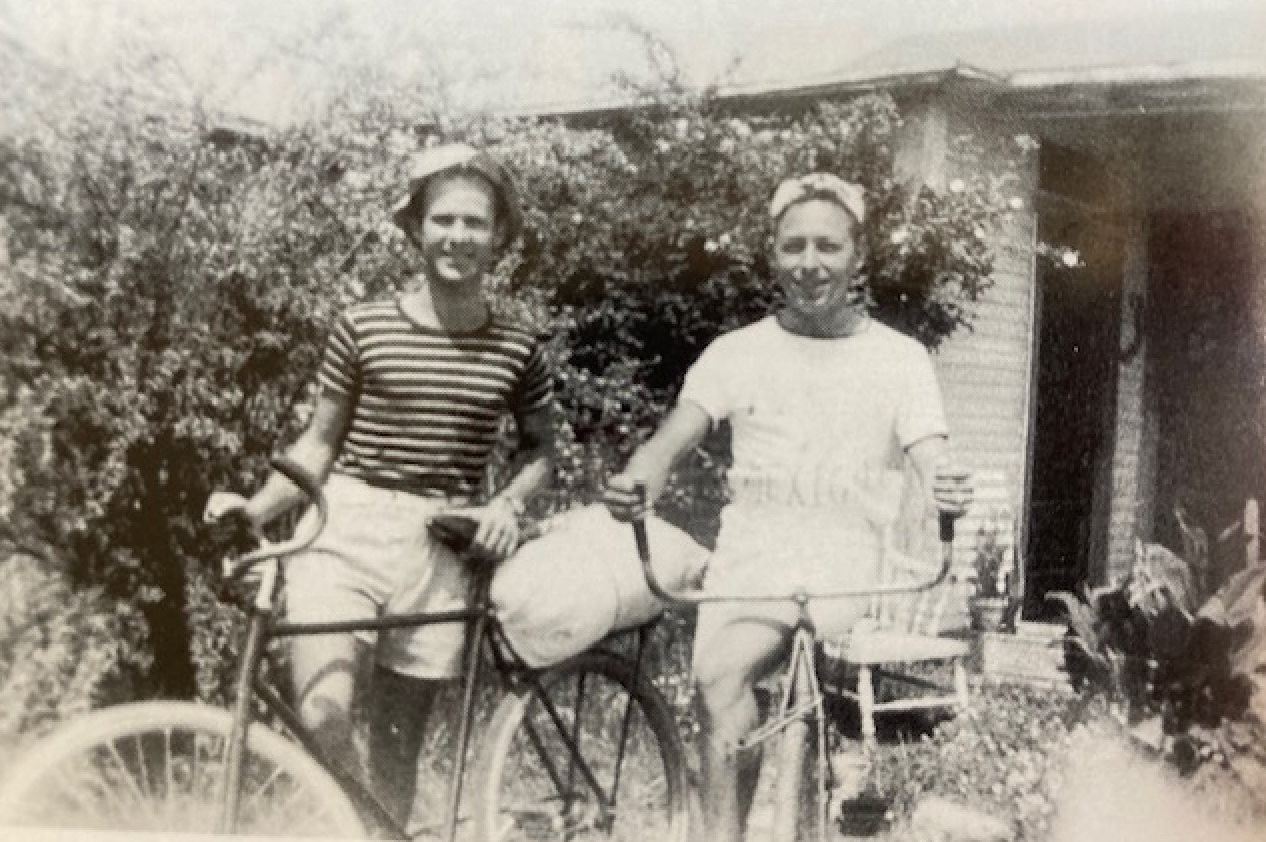
Jim Parrott and Williams biking to Mexico
*
"We went to Tijuana and Agua Caliente, both of which were quite primitive in those days," he wrote in his Memoirs. "The places were primitive and we were innocent." In a border-town cantina, the two young men "discovered that the little kewpie-type god has a predatory nature." When the two rubes returned to the States, they were "considerably less enchanted with Mexican cantinas and their clientele."
Back once again in California, Tennessee got a job as a custodian at a chicken ranch. His duties were light, which allowed him time to enjoy the swimming, surfing and volleyball at Laguna Beach. He recalled that it was "the happiest and healthiest and most radiant time of my life." By the end of that summer, he had acquired a literary agent, Audrey Wood, who suggested he apply for a Rockefeller Fellowship. In August, lonely and "pursued by blue devils," he returned to his family home in St. Louis and then in September headed to New York to meet Wood and start networking with theater people.
Good news came in December: he had won the Rockefeller fellowship. The money and the recognition were a boost to his ego, though he still ached "with desires that are never quite satisfied." Williams considered returning to Mexico for a third visit, this time to attend a drama festival. He planned to stay a month. "Maybe," he recorded in his journal, "that will work the necessary charm although I'm not too expectant of that. Probably be lonely and unhappy down there, too."
Then, quite unexpectedly, the Theatre Guild took a commercial interest in his new play. But plans to mount the show moved slowly. With time on his hands, Williams took off for Provincetown, "at the frolicsome tip" of Cape Cod. There, at the beginning of July, 1940, he met a young dancer named Kip Kiernan. At first glance, he was "hooked like a fish." Their affair didn't last very long and left Williams heartbroken.
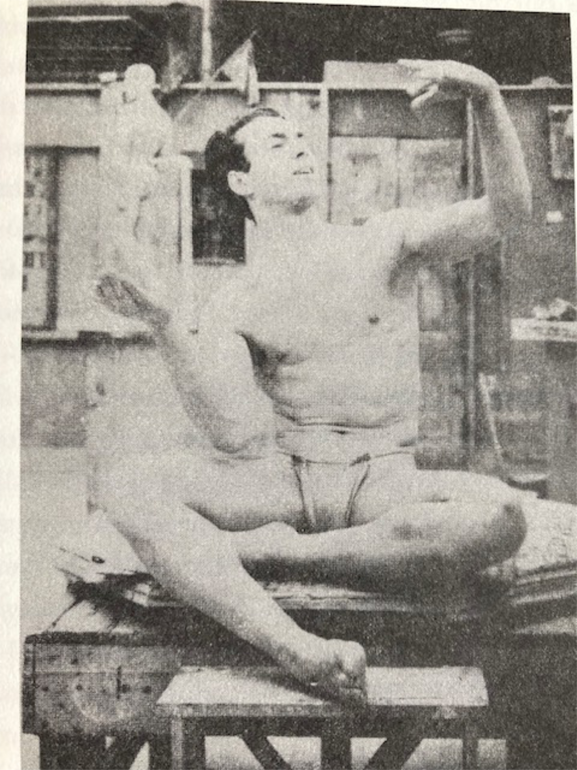
Kip Kiernan
*
"What else can save me now?" he wrote in his journal. The answer was to flee to Mexico again, where he hoped to make new friends and lead "a gay-mad sort of life the first week or two in reaction to what I've been through. Then settle down on the beach and try to catch up with myself."
Through a ride-share agency, he traveled, as he later related in his Memoirs, with "a young Mexican who had come to New York to see the 1940 World's Fair and who had married a prostitute in Manhattan. He was now taking her home to meet his wealthy family in Mexico City." There were three other male Mexicans, who took turns at the wheel, all the while helping themselves to "a gallon of dago red." When the wine ran out, they refilled the bottle with tequila.
Once in Mexico City, Williams checked himself into the YMCA, where he came down with a case of influenza, which morphed into TB. After a week, he moved on to Taxco by bus, and then hitched a ride with a group of American college boys, who drove him to Acapulco, which he'd heard was "a primitive place with much better swimming facilities than the Y."
He first checked into a "fantastic hotel near the central plaza" run by a proprietor who was so fat that he could hardly squeeze into a room at the place. "Every morning, a very lively young barber would arrive to touch up the proprietor's hair with henna and give him a marcel wave and a cold cream facial. Since the dyed, waved hair was quite long and the proprietor spoke in a falsetto voice and was always clad in a bright silk kimono, I wasn't quite sure of his sex till I heard him addressed as Señor something-or-other by one of his employees."
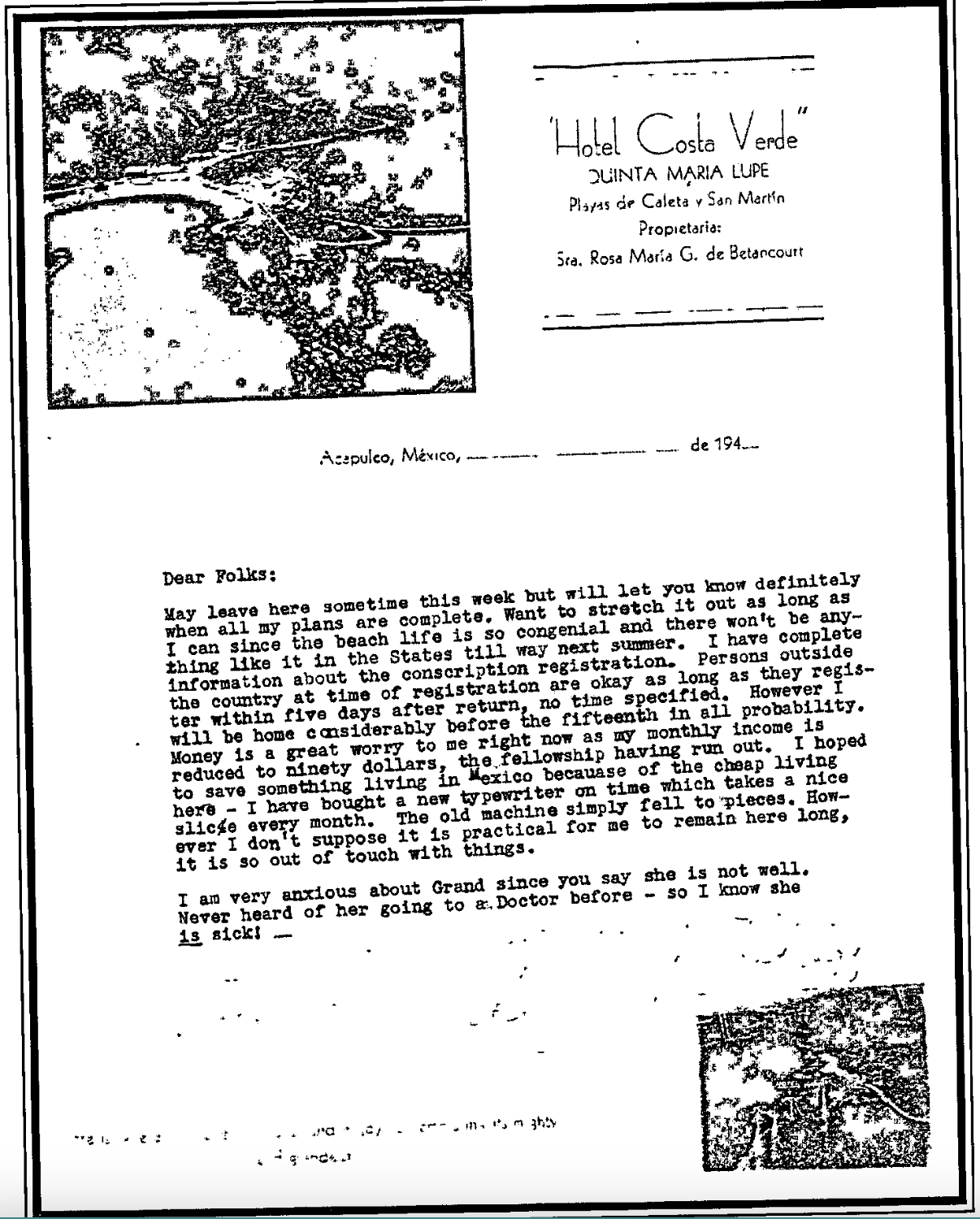
Letter from Costa Verde
*
After a few days, the heat drove Williams to look for other accommodations nearer the water. He eventually settled in at the Hotel Costa Verde, "over the rain-forest and the still-water beach." His daily routine began with strong black coffee to "charge" his nerves, followed by writing at his portable typewriter, which he set up on a card table on the hotel's veranda. He would work until he was exhausted, then run down to the beach for a swim.
During what he called "that crazy summer of 1940," Williams expected to be dead by September. Nevertheless, he greatly enjoyed meeting other people. One such new acquaintance was the American writer and composer Paul Bowles, who later remembered him as "a round-faced, sunburned young man in a big floppy sombrero and a striped sailor sweater."
There were also people at the Costa Verde whom he detested. A party of German Nazis arrived, "jubilant over the fire-bombing of London which was then in progress." The Nazis appalled him. To his friend Joe Hazan, he wrote, "Gentle ideals were impotent enough before—what will become of them now? What will become of us? What will become of our passion for truth in this great Battle of Lies?"
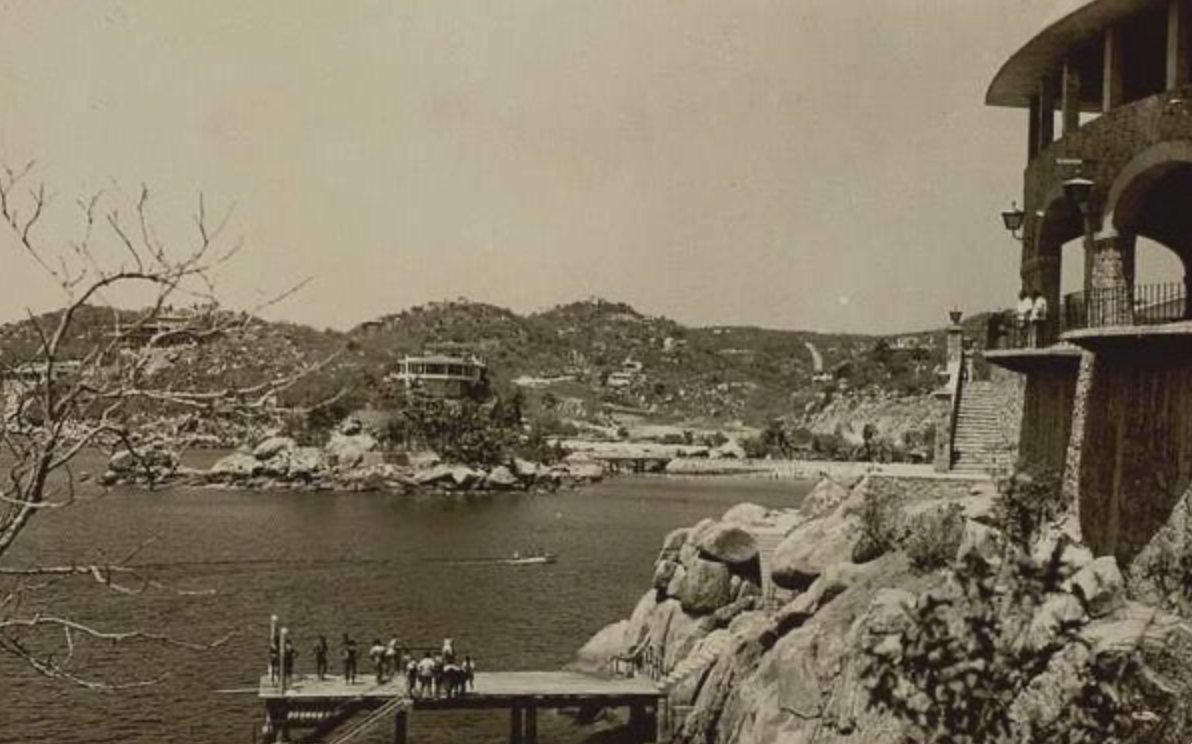
Costa Verde in the 1940s
*
Another writer was also staying at the Costa Verde. He was an extremely wealthy but gloomy young man, who, during their evening conversations over rum cocas, "began to deliver a pitch for suicide as the only decent and dignified way out for either of us." He badgered Williams, telling him he had nothing but the "uncontrolled emotionalism of a minor talent." Williams was, he said, "a cotton-headed romanticist." Happily, for the history of American theater, the cotton-headed romanticist passed on the chance to do himself in.
That summer, between conversations and swims, Williams worked on poems and more theater pieces. He would eventually come to use the Costa Verde twice: once as the locale in a short story, "Night of the Iguana," which he wrote around 1946-48; and, again, over twenty years later, in a full-length play of the same name.
The short story opens on the long veranda of the hotel. It is the off-season, between winter and spring, and there are only three guests: two men who are writers and a thirty-year-old spinster named Edith Jelkes, a former art instructor at a Mississippi girls' school. Miss Jelkes' love life has been stifled by a "proper and squeamish" refinement. It is difficult for her "to cultivate any interior poise." But her interest in the two writers is piqued. She wonders if Mike, the younger one—a "massively constructed" former college athlete—might be a war veteran suffering from shock. And what is his relationship to the older man? Her curiosity becomes so obsessive that she starts to discard "not only her good sense but her strong natural dignity." To her confusion, dismay, and indignation, neither man pays her any attention.
One night, Miss Jelkes discovers that an adolescent Mexican boy has captured an iguana and tied it to a column under the veranda. When she points out to the two writers this example of "Indian savagery right underneath my door," they brush her off. She continues her protest: "There is so much suffering in the world … so much unnecessary suffering." The men still give her no emotional satisfaction or comfort, which only leaves her wondering if her sense of the "enormous grotesquerie of the world" is communicable to any other person.
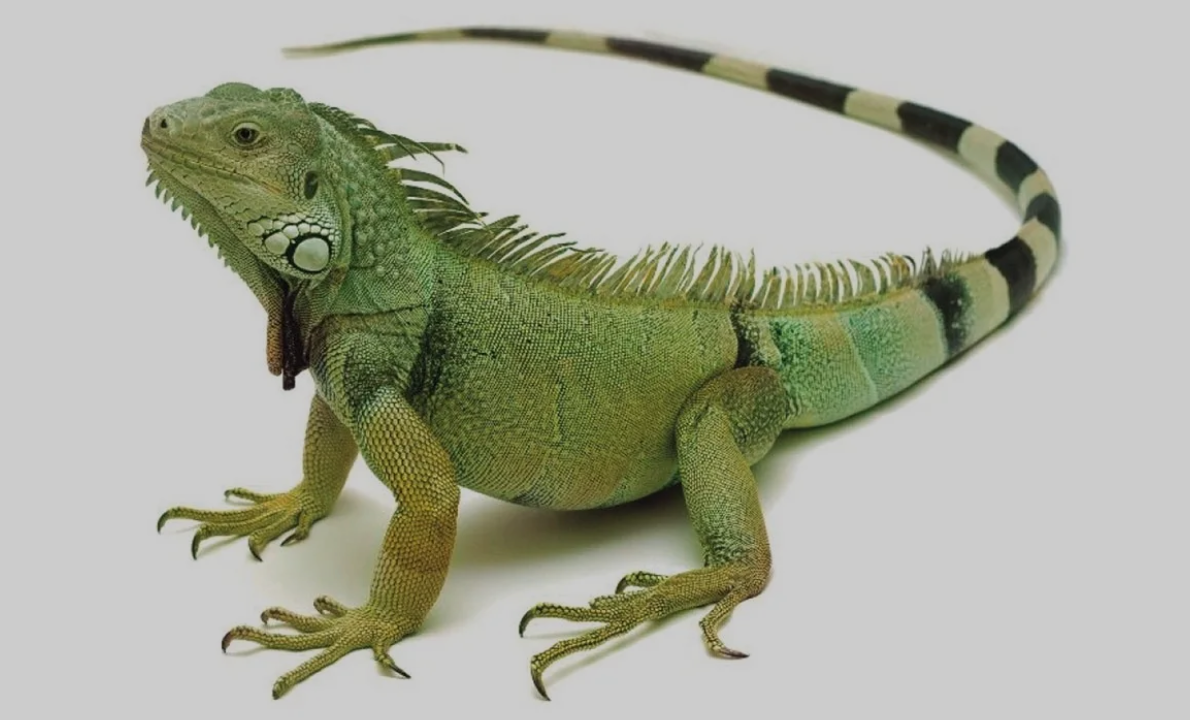
In the morning, with a storm brewing outside, she overhears the two writers talking and laughing about her. When she confronts them, the young writer mutters "a shocking word" and shoves past her; the older writer, still in his pajamas, invites her into his room. She falters, on the verge of "saying incommunicable things to this man whose singularity was so like her own in so many essential ways." Suddenly, the older man sexually attacks her. As his "predatory fingers" dig into her, Miss Jelkes cries out but does not yield: "Some demon of virginity that occupied her flesh fought off her assailant more furiously than he attached her."
Back in her room, she realizes that the iguana has been cut free. And though she now understands that she doesn't belong here, "in some mysterious way the strangling rope of her loneliness had also been severed."
The sexual politics of this story may strike us as problematic today, but in Tennessee Williams' inimitable way, he borrowed from his Mexican sojourn the elements—the dense jungle, the sultry climate, the monstrous animal life, the "Indian" otherness, the freeing of sexual repression—to explore the mysterious, quivering pulse of life beneath the refined veneer of propriety.
I suspect many of us who come to Mexico feel a similar, though perhaps more well-mannered, pulse of life in this vibrant, ever-amazing country. It was a theme Williams explored throughout his career, and certainly in his last fully successful play, The Night of the Iguana, which I'll turn to in next week's column.
**************
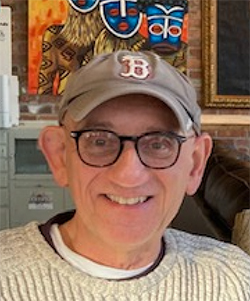
Philip Gambone, a retired high school English teacher, also taught creative and expository writing at Harvard for twenty-eight years. He is the author of five books, most recently As Far As I Can Tell: Finding My Father in World War II, which was named one of the Best Books of 2020 by the Boston Globe. It is available through Amazon, at the Biblioteca bookshop, and at Aurora Books off the Calzada de la Aurora.
**************
*****
Please contribute to Lokkal,
SMA's online collective:
 ***
***
Discover Lokkal:
Watch the two-minute video below.
Then, just below that, scroll down SMA's Community Wall.
Mission

Visit SMA's Social Network
Contact / Contactar

